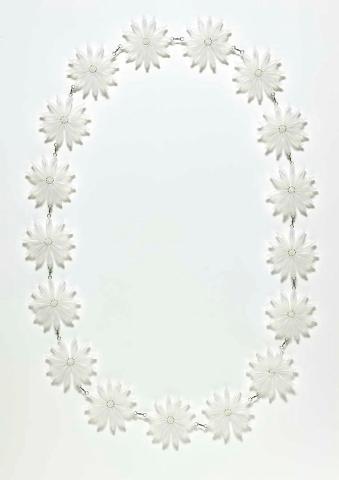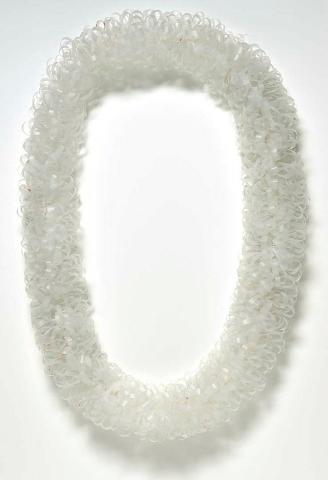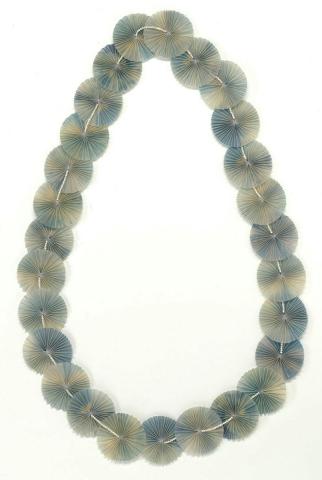Niki Hastings-McFall: 'Urban lei' series
By Donna McColm
August 2002
Niki Hastings-McFall, who was born in 1959 in Auckland, New Zealand, studied at the Manukau Institute of Technology in Auckland, receiving a certificate in contemporary jewellery in 1993, a Diploma of Visual Arts in 1997, and a Bachelor of Visual Arts in 2000. Hastings-McFall has exhibited widely in New Zealand and also in Australia and internationally. Her works are held in numerous public collections in New Zealand as well as in the Tjibaou Cultural Centre, Noumea, New Caledonia and the Museum Fur Volkekunde, Leipzeig, Germany.
Hastings-McFall underwent a dramatic process of self-reflection in the early 1990s, particularly after meeting her Samoan father, James McFall, for the first time, shortly before he died in 1992. Her mother is English and the resulting crossovers between Hastings-McFall's palangi (Samoan for non-indigenous) identity and the ongoing discovery of her Samoan heritage have largely influenced the style and direction of her work. Driven to research her Pacific Islander identity, Hastings-McFall's subsequent works have focused on the junction between Pacific and non-Pacific traditions in contemporary New Zealand society.
Hastings-McFall often uses 'everyday' objects in her art, including disposable shopping bags, bin liners and milk containers. Plastic, itself a medium that exists in flux, is frequently used. She describes her work as mixed-media assemblage, in which she explores issues of being a New Zealander of Pacific Islander descent, living in urban New Zealand in the twenty-first century. However, while the materiality of Hastings-McFall's work is contemporary, the forms are derived from lei, a customary wreath of flowers for the neck. By transforming the lei using modern-day materials, she teases out essential elements and practices to present them in newly constructed and ultra-modern forms.1 The lei has a history very much affected and shaped by colonisation, particularly the introduction of new materials to the Pacific islands. During the nineteenth century, ivory, glass, ceramic, wood and semi-precious stones were incorporated into their design. This changed the structure of the object (and also its symbolism), and thus the relevance of this body adornment has shifted with the political and social structure of many island groups.
As Hastings-McFall contemplates her relationship to the history of colonisation, this 'overtaking' of modern waste, and the changing traditions of lei-making in social groups, underlies the fascinating, intricate and often humorous surfaces of her lei. Perhaps as a way of negotiating her dual identity, the artist is able to explore her place through a continuation of the tradition of body adornment stemming from her Pacific heritage. Hastings-McFall says:
These works were made using the basic principles of lei making — the use of environmental excess and multiple repetitive units. However, unlike their traditional counterparts they do not utilise shells, flowers or seeds, but rather the materials reflect the urban environment common to many Pacific peoples now dwelling in Auckland, the world's largest Polynesian city.2
Hastings-McFall began her 'Urban lei' series in 2000. She has said:
This series of lei is a response to the stereotyping, which so often surrounds the South Pacific. As a European/Samoan, I fit neither culture comfortably. Using the icon to question the myth is an attempt to navigate the waters which both separate and unite the different cultures that myself and others have explored from. The work I produce is a direct result of this exploration.3
Too much sushi II and Shopping, from the 'Urban lei' series, take excess as their medium. In Too much sushi II, 17 clusters of 12 plastic fish-shaped soy sauce containers are connected by small sterling silver rings and linked together evenly by fishing swivels. Like flowers or stars, the clusters are repeated and interconnected by the swivels and more sterling silver jump rings. Too much sushi II celebrates the confluence of multiple cultural influences that occurs in urban centres.
Shopping, formed from uniformly shredded white plastic bags, could be viewed as the detritus of an excessive purchasing spree which has been transformed by the lei-making process into an apparently luxurious object of cultural worth. Of Piha blowhole (from the 'Afio mai Aukilani' series), Hastings-McFall has said:
[It] is made from photocopied images of my grandfather's slide collection put onto tracing paper. My grandparents brought me up and took me on seemingly excruciating long walks in the bush when I was young, and my grandfather's hobby was photography. I remember hanging about for what seemed like hours sometimes so he could get the right conditions for a shot. These images are of places in Auckland that I love and visit regularly and were introduced to me by [my grandparents].4
Piha blowhole is directly linked to Hastings-McFall's experiences of identity and reflects her journey of personal discovery. Here she situates herself between the familiarities of her New Zealand surroundings, as introduced to her through her New Zealand family, while also adopting the lei as a traditional symbol of Pacific identity.
Both highly portable and valuable, jewellery has always played an important role in the historical trade networks of Oceania. Hastings-McFall's contemporary works continue this tradition with an ironic twist, commenting on the various units of social exchange in modern society. Her practice combines a unique blend of traditional Polynesian cultural practice and contemporary materials, formed through an exploration of her personal history.
Essay by Donna McColm, Curatorial Assistant, International Art, August 2002.
Endnotes
- Maud Page, 'Lisa Reihana and the Pasifika Divas: Greed, lust, betrayal and the rivers of fire', in APT 2002: The Asia-Pacific Triennial of Contemporary Art 2002 [exhibition catalogue], Queensland Art Gallery, South Brisbane, 2002, p.91.
- Niki Hastings-McFall, Artist's statement in Island crossings: Contemporary Maori and Pacific art from Aotearoa New Zealand [exhibition brochure], 2000, unpaginated.
- Hastings-McFall, Artist's statement.
- Niki Hastings-McFall, conversation with Maud Page, 17 May 2002.


